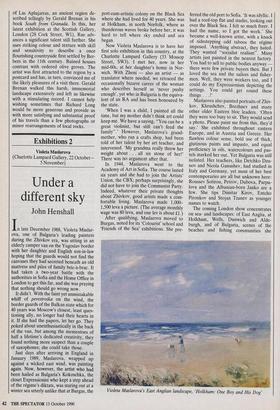ARTS
Exhibitions 1
Richard Long (Tate Gallery, till 6 January) The Broad Horizon: the National Trust's Foundation for Art (Agnew's, till 2 November)
Barbara Rae: the Spanish Paintings (Scottish Gallery, London, till 27 October)
Long walks in the country
Giles Auty
Those with any great liking for his work will probably have rushed by now to the Tate Gallery to see Richard Long's latest offerings, placed or dribbled upon the floor of the refurbished Duveen sculpture galler- ies. These are a rectangular arrangement of slates, a circular arrangement of flint- stones and a meandering monochrome painting executed in a watery paste made from china clay. As the broadsheet pre- pared specially for the exhibition makes plain, Long's status at the Tate ranges by now from that of mystical guru to extra- terrestrial being:
Parallels for his work have been traced in the English landscape tradition of Constable and Nash, in the Taoist and Buddhist traditions of the Far East and in the signs and markings of so-called 'primitive' peoples, such as the ancient Nazca Indians of South America or the Aboriginals of Australia. However, we may observe that like Poussin, Cezanne and Mondrian his art is fundamentally rational, even classical . . . .
Long's early reputation was made as a perambulator; while others painted and sculpted away tediously in their studios, under the impression they were making durable art, he redefined our narrow no- tions of the subject to include the activity of walking. Long walked and walked, often rearranging the landscape somewhat as he did so, usually by making linear or circular arrangements of stones or driftwood. These last were left generously on site when their young author returned finally from his longer and longer journeyings armed with photographic evidence of his deeds. Sometimes he added a text to this, recording the singular fact, for instance, that he had laid one stone per mile on a walk of 164 miles. On other occasions he would dispense with the photographic im- age and substitute a kind of terse, topo- graphical shorthand: 'TURF GORSE TREES FIELD TREES FIELD TREES RIVER' and so on.
Long's personal mystique is of such high standing now that it seems churlish to confine one's criticism to what it is that he does — which is basically to invent compli- cated walks for himself and to make simple, geometrical arrangements of natu- ral materials both indoors and out. The late Peter Fuller found a number of Long's `Distant View of Ross, Chillingham, Northumberland', acrylic on paper, by Derwent Wise, on show at Agnews walking routines, such as tossing the same pebble 3,628 times while circumnavigating Macgillycuddy's Reeks, 'fetishistic'. Their sense and artistic utility certainly strikes me as limited but then I have never subscribed with enthusiasm to the cult of the conceptual.
The more traditional involvement of artists with landscape lay in painting and drawing it. A selection of artists' contem- porary attempts to do this, prompted by the commissioning zeal of the National Trust, can be seen currently at Agnew's (43 Old Bond Street, W1). A number of distinguished names have been co-opted: Diana Armfield, Peter Greenham, John Napper, Edmund Fairfax Lucy, Leonard Rosoman, David Tindle, John Ward, Care Weight and others. All are artists I have written about with some enthusiasm, yet the exhibition as a whole reinforces the feeling that the conventions of landscape have advanced little in the past 150 years, whereas levels of skill have generally fal- len. I absolve Richard Sorrell especially from this stricture on account of his excel- lent aerial perspectives, and was impressed similarly by Derwent Wise whose 'Distant View of Ross, Chillingham, Northumber- land' is an informed and artistically intelli- gent evocation of a wonderfully distinctive locality. One can almost hear Chilling- ham's ancient herd of wild cattle lowing in the distance. Ray Atkins is another who should be better known, his semi- abstracted landscape displaying real feeling for space and place.
Barbara Rae seems to me to fall into the same kind of category. Her vivid paintings based on the experience of staying several weeks in Spain summon up the atmosphere of Las Aplujarras, an ancient region de- scribed tellingly by Gerald Brenan in his book South from Granada. In this, her latest exhibition at the Scottish Gallery, London (28 Cork Street, W1), Rae adv- ances a significant talent still further. She uses striking colour and texture with skill and sensitivity to describe a once flourishing countryside first settled by Ber- bers in the 11th century. Ruined houses contrast with ordered olive groves. The artist was first attracted to the region by a postcard and has, in turn, convinced me of the likely pleasures of a visit there. Gerald Brenan walked this harsh, immemorial landscape extensively and left us likewise with a stimulating record. I cannot help wishing sometimes that Richard Long would be more generous and provide us with more satisfying and substantial proof of his travels than a few photographs or minor rearrangements of local rocks.



























































 Previous page
Previous page